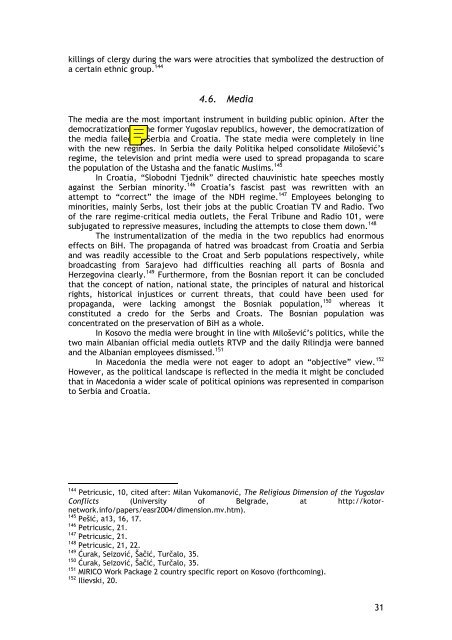Synthetic report - EURAC
Synthetic report - EURAC
Synthetic report - EURAC
Create successful ePaper yourself
Turn your PDF publications into a flip-book with our unique Google optimized e-Paper software.
killings of clergy during the wars were atrocities that symbolized the destruction of<br />
a certain ethnic group. 144<br />
4.6. Media<br />
The media are the most important instrument in building public opinion. After the<br />
democratization of the former Yugoslav republics, however, the democratization of<br />
the media failed in Serbia and Croatia. The state media were completely in line<br />
with the new regimes. In Serbia the daily Politika helped consolidate Milošević’s<br />
regime, the television and print media were used to spread propaganda to scare<br />
the population of the Ustasha and the fanatic Muslims. 145<br />
In Croatia, “Slobodni Tjednik” directed chauvinistic hate speeches mostly<br />
against the Serbian minority. 146 Croatia’s fascist past was rewritten with an<br />
attempt to “correct” the image of the NDH regime. 147 Employees belonging to<br />
minorities, mainly Serbs, lost their jobs at the public Croatian TV and Radio. Two<br />
of the rare regime-critical media outlets, the Feral Tribune and Radio 101, were<br />
subjugated to repressive measures, including the attempts to close them down. 148<br />
The instrumentalization of the media in the two republics had enormous<br />
effects on BiH. The propaganda of hatred was broadcast from Croatia and Serbia<br />
and was readily accessible to the Croat and Serb populations respectively, while<br />
broadcasting from Sarajevo had difficulties reaching all parts of Bosnia and<br />
Herzegovina clearly. 149 Furthermore, from the Bosnian <strong>report</strong> it can be concluded<br />
that the concept of nation, national state, the principles of natural and historical<br />
rights, historical injustices or current threats, that could have been used for<br />
propaganda, were lacking amongst the Bosniak population, 150 whereas it<br />
constituted a credo for the Serbs and Croats. The Bosnian population was<br />
concentrated on the preservation of BiH as a whole.<br />
In Kosovo the media were brought in line with Milošević’s politics, while the<br />
two main Albanian official media outlets RTVP and the daily Rilindja were banned<br />
and the Albanian employees dismissed. 151<br />
In Macedonia the media were not eager to adopt an “objective” view. 152<br />
However, as the political landscape is reflected in the media it might be concluded<br />
that in Macedonia a wider scale of political opinions was represented in comparison<br />
to Serbia and Croatia.<br />
144<br />
Petricusic, 10, cited after: Milan Vukomanović, The Religious Dimension of the Yugoslav<br />
Conflicts (University of Belgrade, at http://kotornetwork.info/papers/easr2004/dimension.mv.htm).<br />
145<br />
Pešić, a13, 16, 17.<br />
146<br />
Petricusic, 21.<br />
147<br />
Petricusic, 21.<br />
148<br />
Petricusic, 21, 22.<br />
149<br />
Ćurak, Seizović, Šačić, Turčalo, 35.<br />
150<br />
Ćurak, Seizović, Šačić, Turčalo, 35.<br />
151<br />
MIRICO Work Package 2 country specific <strong>report</strong> on Kosovo (forthcoming).<br />
152 Ilievski, 20.<br />
31

















